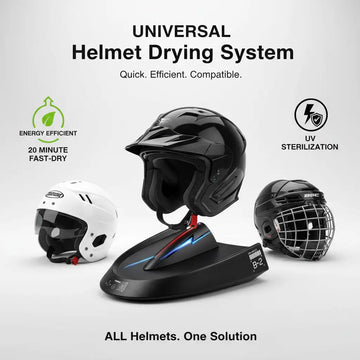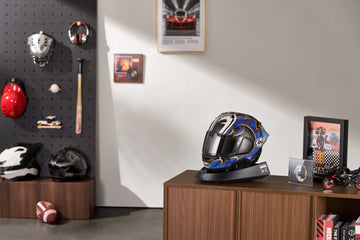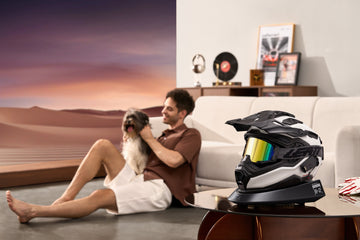Helmet Dryer vs Air-Dry: Safer, Faster Helmet Care (With a Simple Home Test)
Updated: 2025-09-22 (JST) · By OPLACE Test Team
A damp helmet isn’t just uncomfortable—it accelerates liner wear, encourages odor-causing bacteria, and can compromise safety. This guide shows when air-drying is enough and when a helmet dryer wins, using a repeatable home test and a rider-proof routine. The goal isn’t maximum heat; it’s controlled, even, low-temp airflow.
TL;DR
- Air-dry is fine for light sweat in a dry, ventilated room when you’re not riding soon.
- Helmet dryer is better after rain, heavy sweat, or when you need a quick, consistent turnaround.
- Think low temperature + even airflow, not “hotter/longer is better”.
Why Proper Drying Matters
- Hygiene & odor: Moisture + warmth = bacteria growth and persistent smells.
- Material health: Excess heat or trapped moisture can weaken foam, glue, and shell integrity.
- Comfort & fit: A fully dry liner keeps the fit predictable from ride to ride.
A Simple, Repeatable Home Test (Air-Dry vs Helmet Dryer)
Goal: Compare touch-dry feel, odor return, and time cost—without fake lab numbers.
Setup: Room temp ~22–26 °C, humidity 45–60 %; tools: spray bottle, timer, microfiber cloth.
- Mist the liner evenly until clearly damp (not dripping).
- Group A: Air-dry in a ventilated room (no heater blast).
- Group B: Helmet Dryer on low-temp / gentle airflow.
- Check at 10-min intervals: touch feel (dry / slightly damp / wet) + odor (none / light / obvious).
What most riders observe (typical, not guaranteed):
- Helmet dryer reaches “ride-ready dry” in about 20–40 min; air-dry takes longer and varies with room airflow.
- Odor rebound is lower with the helmet dryer; air-dry depends heavily on ambient humidity.
- The win isn’t temperature; it’s steady, low-temp airflow through the liner.
When Air-Drying Is Enough vs When a Helmet Dryer Wins
Air-Dry Works Best When…
- Sweat is light and you’re not riding soon.
- The room is dry & well ventilated.
- You can remove liners and hang them freely.
Helmet Dryer Wins When…
- After rain rides, heavy sweat, or humid lockers/garages.
- You need overnight or back-to-back turnaround.
- You want drying + light deodorizing in one step.
Safe, No-Overdry Settings (Do This)
- Use low-temp / gentle airflow; avoid direct high heat.
- Keep vents and channels open—don’t block outlets.
- Time-box in 20-min blocks; stop once touch-dry and odor-neutral.
- If your model includes UV, avoid direct viewing and follow material guidance.
- After the cycle, crack the visor for 2–3 min of passive venting.
A 10-Minute Post-Ride Routine (Printable)
- Shake off droplets → quick microfiber dab on straps & hotspots.
- Helmet dryer on low for 10–20 min.
- Faint odor? Add 5–10 min or place a small carbon sachet nearby.
- Weekly: remove liners for a full wash and ensure they are completely dry before reinstalling.
Pro Tips from Riders & OPLACE Testers
- A thin liner cap reduces sweat reaching the pads, speeding up drying.
- If salt residue appears on straps, rinse with clean water and air-dry—don’t bake it.
- Full-face helmets: open the visor and use a slight face-down tilt so airflow passes through the liner.
FAQ
Can I just use a hair dryer?
You can, but high heat at close distance risks softening adhesives and localized overheating. A helmet dryer provides controlled, even, low-temp airflow, which is safer for long-term use.
Will a helmet dryer damage the liner?
Not when kept to low temperature and reasonable time (20–40 min). Avoid the “hotter/longer is better” myth.
Is UV necessary?
UV is a useful assist for odor-causing microbes; drying is the main job. Focus on airflow and time first.
How do I know it’s dry enough?
No cool-damp feel on press, no musty smell, no visible moisture on pads/straps.
Motorcycle / ski / football helmets too?
Yes. Larger volumes may need an extra 10–15 min and ensuring no airflow paths are blocked.
Recommended Tool
OPLACE Smart Helmet Dryer — fast drying with low-temp airflow; UV + negative-ion deodorizing assist; compatible with motorcycle, bike, and ski helmets.
Related Reads
- Remove Helmet Odor Without Ruining the Padding
- Rainy-Season Helmet Care: Setup & Routine
- UV in Helmet Care: What It Does & Doesn’t Do






